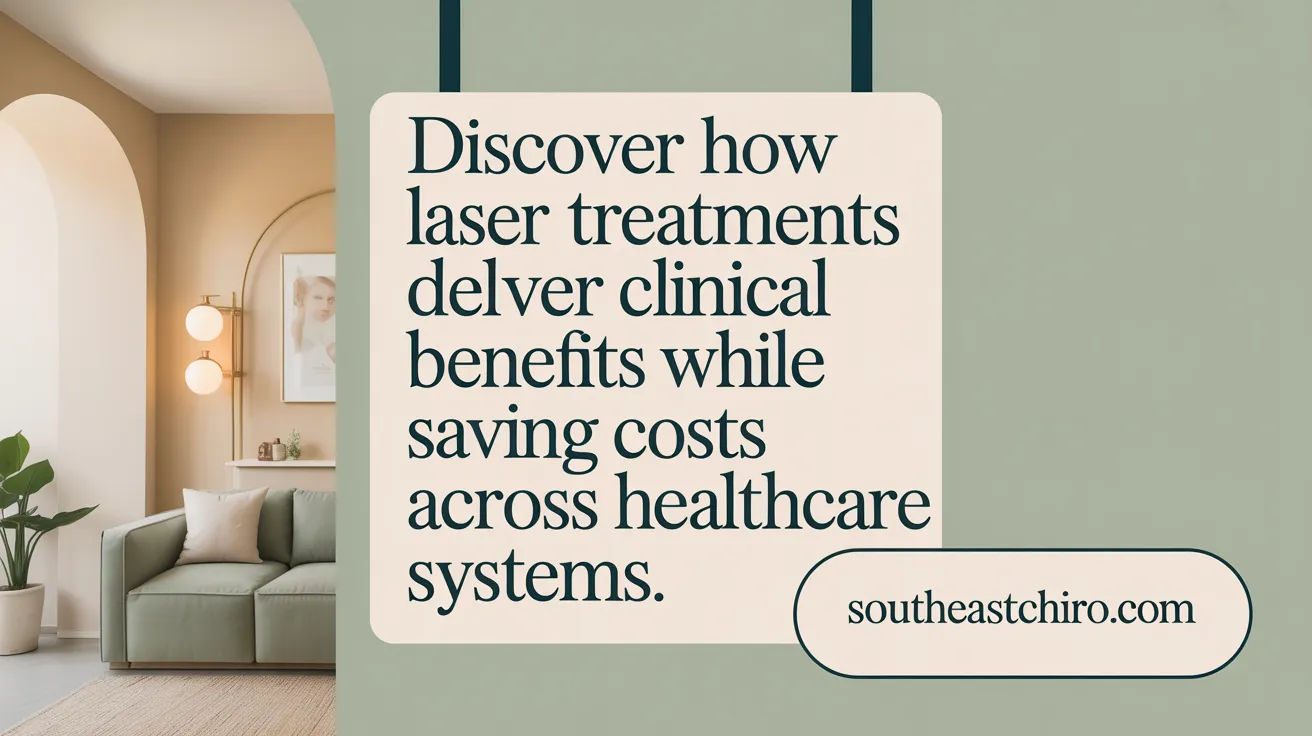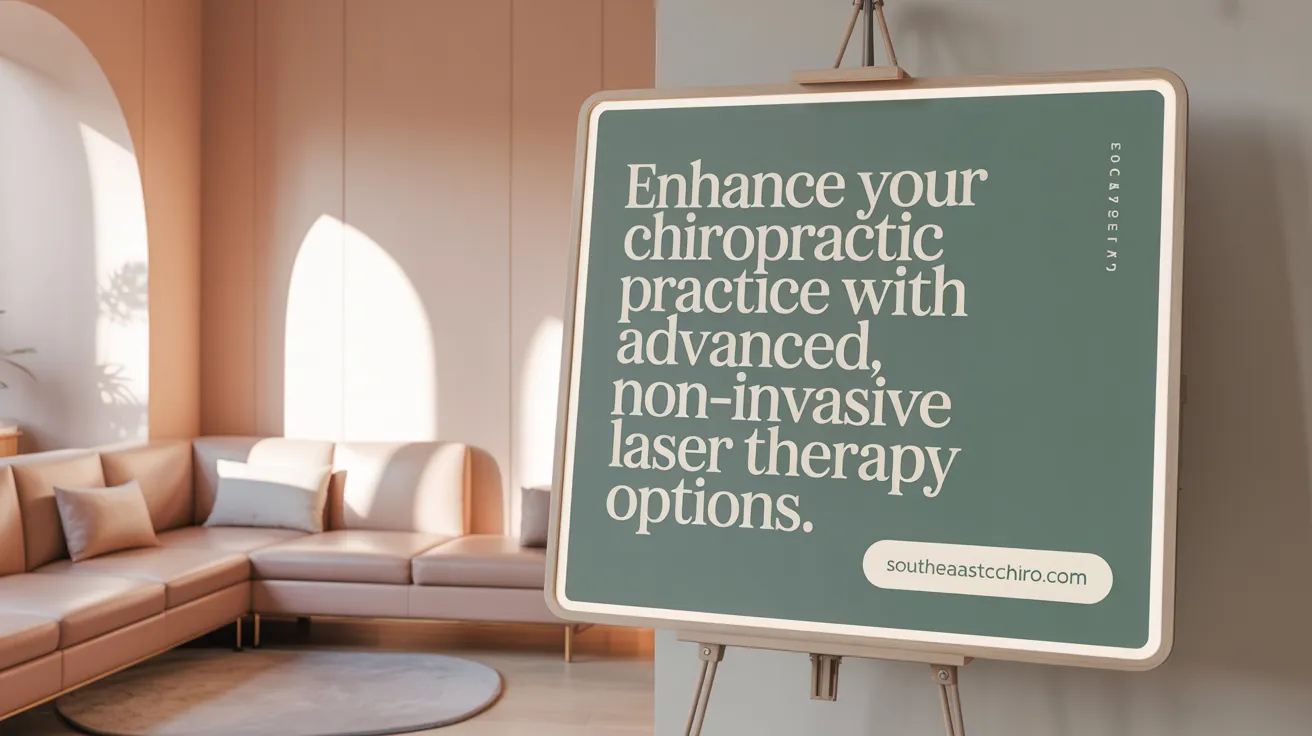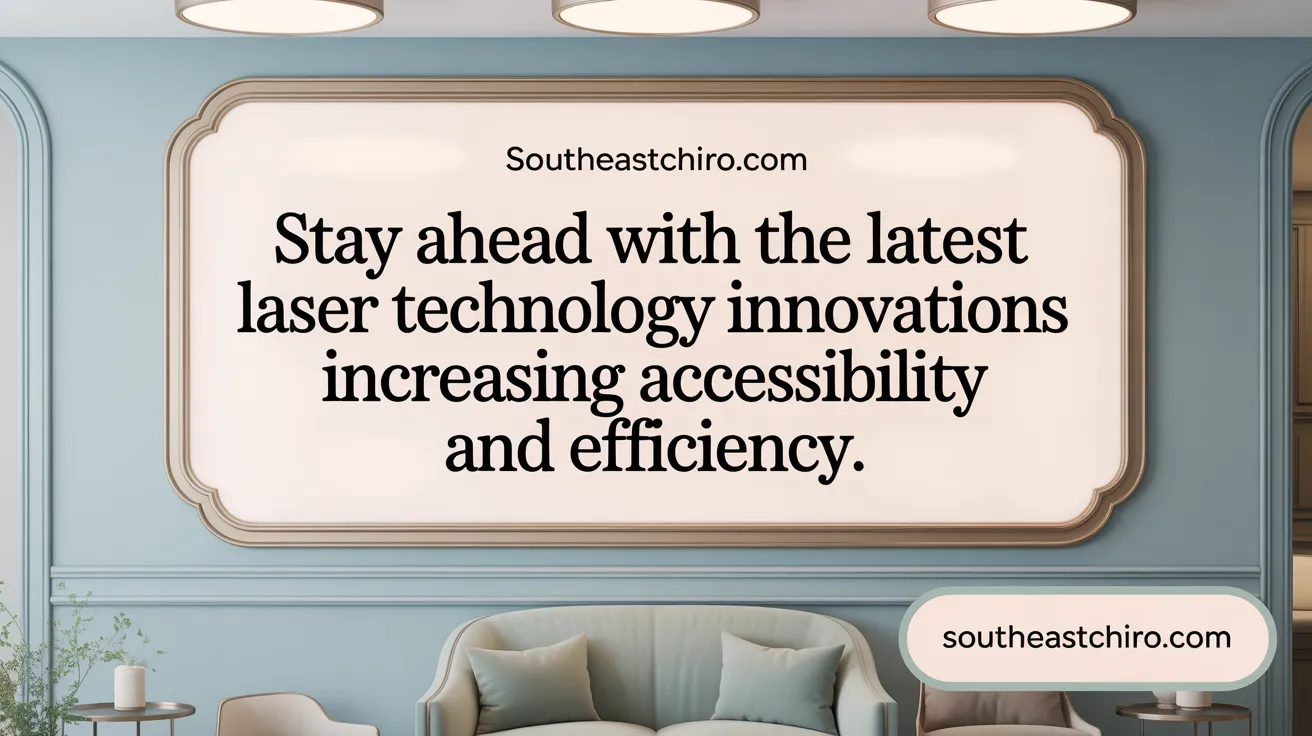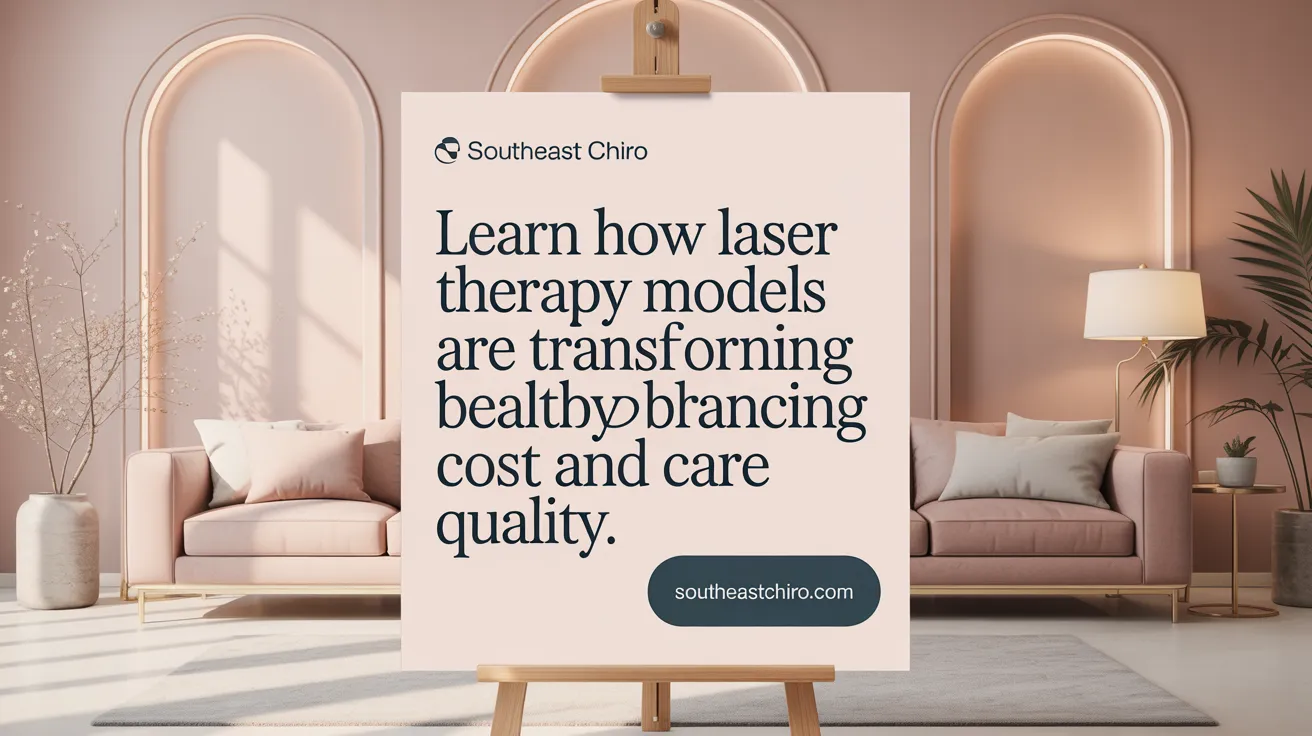Introducing Laser Therapy as a Sustainable Health Innovation
Role of laser therapy in modern healthcare
Laser therapy represents a significant advancement in medical treatment, offering a range of applications from pain relief to surgical interventions. It is widely used for managing musculoskeletal disorders, aiding recovery after injuries, and treating conditions like diabetic macular oedema and cancer. The precision of lasers allows targeted treatment with reduced damage to surrounding tissues, leading to faster recovery and improved patient outcomes.
Basic principles and types of laser therapy
Laser therapy utilizes focused, coherent light at specific wavelengths, generally between 600 to 1100 nm, to penetrate tissues and stimulate healing processes. Low-Level Laser Therapy (LLLT), also called photobiomodulation, promotes cellular repair by increasing ATP production and reducing inflammation without generating heat. Class IV lasers offer higher power for deeper penetration and quicker treatments.
Types of laser therapies include:
- Low-Level Laser Therapy (LLLT): Non-invasive, suitable for pain relief and promoting tissue repair.
- Subthreshold Micropulse Laser (SML): Used for retinal diseases with minimal tissue damage.
- Standard Threshold Laser (SL): Traditional laser treatment applied to various conditions.
Overview of cost-effectiveness studies in laser applications
Recent studies highlight the economic benefits of laser therapies. For diabetic macular oedema, subthreshold micropulse laser (SML) demonstrated similar effectiveness to traditional lasers but at lower healthcare costs over 24 months. In glaucoma treatment, selective laser trabeculoplasty (SLT) proved cost-saving and improved quality-adjusted life years compared to medical therapy.
In cancer care, low-level laser therapy (LLLT) has reduced treatment complications like oral mucositis, decreasing overall healthcare costs. Additionally, laser surgery for burn reconstruction shows substantial long-term savings and improved patient outcomes. These findings support laser therapy as a sustainable and cost-effective innovation in healthcare delivery.
Understanding Laser Therapy: Mechanisms and Applications

Low Level Laser Therapy (LLLT) and Photobiomodulation
Low Level Laser Therapy, commonly known as LLLT or photobiomodulation, utilizes low-intensity light to stimulate cellular repair and promote healing without generating heat. It typically employs wavelengths ranging from 660 to 905 nm and power outputs between 10 mW and 500 mW. These wavelengths penetrate the skin and tissues effectively, facilitating biochemical changes such as increased ATP production in mitochondria and reduced inflammation.
Wavelengths and Power Ranges Used in Medical Lasers
Medical lasers use specific wavelength ranges tailored to their application. LLLT operates primarily in the red to near-infrared spectrum (660–905 nm), classified as Class III lasers with power below 0.5 watts. In contrast, Class 4 lasers have higher power outputs, between 9 and 60 watts, and often use wavelengths near 810 nm, enabling deeper tissue penetration and faster treatment times.
Common Clinical Uses in Pain, Inflammation, and Healing
Laser therapy is widely used to manage both acute and chronic conditions involving pain, inflammation, and impaired healing. Conditions such as arthritis, tendonitis, neuropathic pain, sprains, strains, and post-surgical recovery benefit from laser treatments by experiencing pain relief, inflammation reduction, and accelerated tissue regeneration. This makes laser therapy a valuable adjunct to therapeutic programs, including chiropractic care.
Class 4 Lasers and Their Advantages
Class 4 lasers provide higher power that allows quicker and more effective treatments for larger or deeper bodily areas. Their ability to deliver concentrated photons at greater depths supports enhanced pain control, improved blood circulation, and reduced inflammation. Furthermore, advancements have made these typically expensive devices more accessible, offering faster treatment sessions—usually under 12 minutes—and greater flexibility in clinical applications.
How Does Laser Therapy Complement Chiropractic Care?
Laser therapy in chiropractic treatments employs targeted light wavelengths to stimulate healing processes at the cellular level, reduce inflammation, and alleviate pain in neuromusculoskeletal disorders. It acts as a non-invasive complement to spinal adjustments and rehabilitation, promoting quicker recovery and broader management of conditions like neck and back pain, sports injuries, and arthritic ailments.
This combined approach improves patient outcomes by harnessing laser therapy's analgesic and reparative properties alongside manual care techniques, offering a comprehensive, drug-free treatment strategy. For more on the integration of laser therapy in chiropractic practice see Is Your Practice Missing Out on Laser Therapy?
Evidence-Based Effectiveness of Laser Therapy Across Conditions
Clinical trial results on LLLT for pain and wound healing
Low Level Laser Therapy (LLLT), or photobiomodulation, has strong clinical support from over 400 Phase III randomized trials demonstrating its capability to reduce pain, inflammation, and promote tissue repair. Applications include musculoskeletal disorders, neuropathic pain, and wound healing. LLLT stimulates cellular processes such as ATP production and fibroblast proliferation, facilitating faster recovery. However, some studies show mixed results, suggesting patient response varies and more long-term evaluations are needed (source).
Use in diabetic macular oedema treatment
In diabetic macular oedema, subthreshold micropulse laser (SML) matches the visual outcomes of standard threshold laser (SL) therapy while lowering treatment costs. Over a 24-month period, SML reduced NHS costs by approximately £228 and achieved slightly better quality-adjusted life years (QALYs), showing an 71%-80% probability of cost-effectiveness. SML's non-inferiority to SL supports its integration into cost-efficient care models (health economic analysis).
LLLT in managing oral mucositis during cancer therapy
LLLT has been proven cost-effective in preventing severe oral mucositis in head and neck cancer patients undergoing chemoradiation. A phase III trial reported reduced hospitalization, opioid use, and feeding tube dependence, offsetting the $1689 additional cost of LLLT per patient. The incremental cost-effectiveness ratio was $4961 per prevented case of grade 3–4 mucositis, below acceptable thresholds, thus improving patient quality of life and reducing treatment morbidity (Cost-effectiveness of low-level laser therapy (LLLT), Phase III randomized LLLT trial).
Applications in musculoskeletal and neuropathic conditions
LLLT effectively treats acute and chronic musculoskeletal conditions such as osteoarthritis, rheumatoid arthritis, tendinitis, and neuropathic pain. It achieves analgesia by neural blockade, inflammation reduction, and enhanced blood flow, producing rapid pain relief often within a few sessions. Its non-invasive, drug-free nature aligns with natural healing philosophies, particularly benefiting chiropractic practices which emphasize holistic and systemic wellness (Low Level Laser Therapy, Laser therapy for pain relief and recovery).
How do chiropractic practices emphasize holistic and natural healing?
Chiropractic clinics incorporate laser therapy to complement their focus on whole-body health by promoting non-invasive, drug-free treatments that stimulate intrinsic healing. LLLT acts at the cellular level to reduce inflammation, aid tissue repair, and improve neurological function, embodying chiropractic principles aimed at addressing root causes and supporting systemic wellness rather than symptom suppression alone (laser therapy benefits in chiropractic).
Healthcare Economic Evaluations Demonstrate Cost-Effectiveness of Laser Therapy

Comparative cost studies of laser therapy versus standard treatments
Several health economic analyses have shown laser therapy to be a cost-effective alternative to conventional treatments across various medical conditions. For example, studies comparing subthreshold micropulse laser vs standard threshold laser for diabetic macular oedema found that SML was not only equally effective but also less costly over a 24-month period, with mean costs of £897.83 for SML versus £1125.66 for SL. Similarly, a Markov state-transition model for glaucoma assessing selective laser trabeculoplasty (SLT) for glaucoma treatment demonstrated laser as a dominant strategy with cost savings and improved quality-adjusted life years (QALYs) over standard medication.
Cost savings in diabetic macular oedema and glaucoma care
Laser therapy treatments for diabetic macular oedema and glaucoma present economic advantages by reducing long-term healthcare costs and improving patient outcomes. In diabetic macular oedema, SML reduced expenses related to laser treatment and associated interventions, contributing to overall cost-effectiveness. The glaucoma economic model reported laser therapy resulting in fewer surgeries, lower medication use, and better health utilities, achieving an approximate 90% probability of cost-effectiveness at typical healthcare willingness-to-pay thresholds (£20,000 per QALY) (economic healthcare models for diabetic macular oedema and glaucoma).
Economic benefits in burn reconstruction using laser surgery
Laser surgery for secondary burn reconstruction addresses complications such as scar tightness and keloid scars effectively while delivering notable economic benefits. Evidence from a 22-year retrospective analysis at a UK hospital revealed substantial cost savings and improved surgical outcomes compared to traditional methods (Cutaneous laser surgery for burn reconstruction). Laser services reduced infection risks to less than 1% and improved range of movement, demonstrating laser surgery as a sustainable and financially advantageous investment for healthcare systems over the medium to long term.
Cost-effectiveness ratios and quality-adjusted life years (QALYs)
Cost-effectiveness is often measured by incremental cost-effectiveness ratios (ICER) and QALYs gained. For example, laser therapy in diabetic macular oedema showed a marginal QALY increase of 0.008 (approximately 3 days of good quality life) compared to SL. ICER analysis indicated that SML dominated SL, being both less costly and slightly more effective, with cost-effectiveness probability ranging from 71% to 80% (cost-effectiveness of SML and SL. In glaucoma therapy, laser-first treatment yielded an average of 12.5 QALYs versus 12.3 for medication, coupled with cost savings, supporting laser therapy as a cost-effective treatment choice (Markov model in glaucoma evaluation.
These evaluations highlight laser therapy as an economically advantageous option in healthcare, offering comparable or superior effectiveness with substantial cost savings and improved patient quality of life.
Laser Therapy Integration in Chiropractic Practices: Advantages and Business Impact

Enhancing treatment outcomes with laser therapy
Integrating laser therapy into chiropractic care enhances pain relief and reduces inflammation by stimulating cellular repair and promoting faster healing. This noninvasive method effectively manages conditions like back pain, sports injuries, and arthritis. By complementing traditional adjustments, laser therapy helps chiropractors achieve better patient outcomes, improving mobility and reducing recovery times with minimal discomfort.
Attracting patients seeking advanced pain management
Offering laser therapy attracts patients who prefer drug-free and cutting-edge treatments for neuromusculoskeletal issues. The appeal of painless, quick sessions makes it an attractive alternative for those hesitant about conventional pain relief methods. Practices incorporating this technology can draw new patient groups interested in advanced therapeutic options (Benefits of Laser Therapy).
Cash-based service benefits and increasing profitability
Laser therapy operates as a cash-based service, providing chiropractors with an additional revenue stream independent of insurance reimbursement challenges. As demand grows for effective, noninvasive pain management, offering laser treatments can boost profitability by attracting more paying patients and fostering repeat visits due to treatment courses (laser therapy benefits.
Differentiation in competitive healthcare markets
Incorporating laser therapy differentiates chiropractic practices by showcasing advanced care capabilities. This positions the practice as innovative and patient-focused, helping it stand out in crowded healthcare markets. Enhanced treatment portfolios can also improve patient retention and referral rates, further expanding the client base (Cutting Edge Laser Technologies.
Building trust and accessibility on chiropractic websites
Chiropractic websites that highlight laser therapy build trust by offering clear, evidence-based educational content explaining treatment benefits and safety measures. Including patient testimonials and detailed descriptions of laser technologies enhances transparency. User-friendly appointment scheduling, responsive design, and optimized searchability make the practice more accessible and professional in the digital space, encouraging patient confidence in advanced treatments (Low Level Laser Therapy.
Patient Education and Safety Considerations in Laser Therapy
What role does patient education play in chiropractic care?
Patient education is crucial in chiropractic care, especially when incorporating laser therapy. Informing patients about how laser therapy works, its benefits, and potential risks helps build trust and ensures they have realistic expectations. This knowledge enables patients to make informed decisions and adhere better to treatment plans, improving overall outcomes.
Importance of educating patients on laser treatment benefits and risks
It's essential to clearly explain that laser therapy is generally safe, non-invasive, and often offers rapid pain relief and healing stimulation with minimal side effects. Patients should also be aware that individual responses may vary, and multiple sessions might be needed for lasting effects. Highlighting possible sensations during treatment and typical recovery expectations helps reduce anxiety.
Safety protocols to prevent injury
Strict safety measures are mandatory, including the use of protective eyewear by both patient and practitioner to prevent eye damage. Operators must avoid pointing lasers at eyes and ensure correct dosage and movement of the laser during treatment to prevent tissue harm. Practitioners follow laser safety guidelines to minimize any adverse effects, which are rare and mostly comparable to placebo symptoms.
Contraindications and precautions in laser use
Patients should be informed about contraindications, such as avoiding laser therapy over known cancerous lesions (unless part of palliative care), pregnancy, over the developing fetus, and in individuals with photosensitive epilepsy. Avoiding treatment on areas with skin infections or recent antiviral exposure is also advised. These precautions help keep therapy safe and effective as described in LLLT contraindications and safety precautions.
Ongoing research and patient informed consent
Laser therapy continues to be studied extensively, improving understanding of mechanisms, optimal dosages, and efficacy for various conditions. Educating patients on the experimental aspects in some areas and the evolving evidence base promotes transparency, as supported by clinical and laboratory studies of LLLT. Informed consent involves discussing all benefits, risks, and alternatives, empowering patients in their care decisions.
Together, thorough patient education and strict adherence to safety protocols ensure laser therapy is a safe, effective, and well-understood option within chiropractic and other healthcare practices.
Laser Therapy’s Role in Family and Prenatal Chiropractic Care
How can chiropractic care benefit families and prenatal patients?
Laser therapy complements chiropractic care for families and prenatal patients by providing gentle, non-invasive pain relief and facilitating tissue healing without drugs or surgery. This makes it a safe option for pregnant women and children (laser therapy benefits.
Benefits of laser therapy for prenatal discomforts and musculoskeletal issues
During pregnancy, women often face back pain, joint discomfort, and pelvic challenges. Laser therapy helps reduce inflammation, edema, and pain, promoting faster tissue repair and improving circulation (LLLT inflammation reduction). This supports pelvic health and eases musculoskeletal stresses, offering relief without medications.
Supporting pelvic health and pain relief during pregnancy
By targeting affected tissues with specific wavelengths, laser therapy encourages cellular repair and reduces nociceptive signals (Low Level Laser Therapy benefits. This improves range of motion and decreases stiffness in pregnancy-affected areas, contributing to enhanced comfort and stability.
Use in pediatric and family care settings to enhance healing
Laser therapy is effective in treating common family health issues such as sprains, strains, and post-surgical recovery (Healing with Laser Therapy. Its non-invasive nature is ideal for children, providing pain relief and supporting healing processes safely and without side effects (Non-invasive pain relief.
Non-invasive nature supporting safety in sensitive populations
Unlike many treatments involving medications or surgery, laser therapy uses low-level light that does not generate heat or vibration, making it minimally discomforting and safe for pregnant women and pediatric patients (LLLT safety precautions). This allows integration into family chiropractic programs to improve outcomes and patient satisfaction.
Advancements and Technology Trends Making Laser Therapy More Accessible

Affordable Class 4 therapy lasers and their clinical advantages
Class 4 lasers, which typically range from 9 to 60 Watts, have become more affordable, with prices dropping 30% to 60%. These lasers deliver higher power that allows for faster and more effective treatments by maximizing photon density. This high power enhances tissue penetration and saturation, enabling treatment of larger or deeper areas in shorter sessions, often less than 12 minutes.
These lasers use wavelengths around 810 nm, considered the gold standard for photobiomodulation due to its deep penetration and efficient photo-chemical effects. Class 4 lasers also afford flexibility to reduce inflammation, increase blood circulation, and promote faster healing by treating distributed areas through specialized handpieces. For more details, see Affordable Class 4 Therapy Lasers.
Increased availability and reduced costs of laser technology
Recent years have seen a surge in the availability of advanced laser therapy systems due to technological improvements and cost reduction. More healthcare providers and clinics are integrating laser therapy as part of their treatment options, given that affordability has improved and patient demand for non-invasive pain management grows.
This greater availability helps expand access to therapies that are effective for a variety of indications, from musculoskeletal disorders to chronic inflammation, reducing dependence on pharmaceuticals and invasive surgeries. Learn more about these benefits at Benefits of Laser Therapy and Laser therapy for pain and recovery.
Emerging applications and integration with other modalities
Laser therapy is increasingly used in combination with other treatment modalities, such as chiropractic care and physical therapy. This integrated approach enhances therapeutic outcomes by combining the cellular repair stimulation of laser therapy with manual adjustments or rehabilitative exercises.
Emerging applications also include rehabilitation for sports injuries, post-surgical recovery, and chronic pain management. The expanding research base supports laser therapy as a versatile tool effective across acute and chronic conditions. For further insights, see Laser therapy with chiropractic care and Role of Laser Therapy in Physical Therapy.
Training, safety standards, and regulatory approvals
With the rise in use, safety standards and operator training have become critical. Proper precautions, including protective eyewear and avoidance of treatment over malignancies or sensitive areas, are mandatory.
Additionally, devices have received FDA clearance in many regions, reassuring patients and practitioners of the technology’s safety and efficacy. Ongoing training ensures clinicians use optimal wavelengths, power settings, and treatment protocols, maximizing benefits while minimizing risks. For more on laser therapy safety and FDA clearance, visit What is laser therapy? and Laser therapy safety precautions.
Advancements have positioned laser therapy as a practical, non-invasive, and efficient treatment method that is more accessible and accepted in diverse healthcare settings today.
Summary: Laser Therapy as a Keystone in Economical Healthcare Models

Consolidation of cost savings and clinical effectiveness
Laser therapies such as subthreshold micropulse laser (SML) and low-level laser therapy (LLLT) have demonstrated both clinical effectiveness and economic benefits. Studies have shown that SML provides visual outcomes comparable to standard threshold laser but at lower healthcare costs, saving approximately £365 over two years (health economic analysis, subthreshold micropulse laser vs standard threshold laser, cost comparison of SML and SL, visual outcomes of SML and SL, cost-effectiveness of SML, quality-adjusted life years gain with SML, incremental cost-effectiveness ratio of SML, probability of cost-effectiveness of SML, economic implications of laser therapy for diabetic macular oedema, NHS and PSS costs for laser treatments, cost savings with subthreshold micropulse laser, economic healthcare models for diabetic macular oedema. Similarly, LLLT has proven cost-effective for preventing complications like oral mucositis in cancer patients, reducing opioid use and hospitalizations while improving quality of life (Cost-effectiveness of low-level laser therapy (LLLT), Prevention of oral mucositis with LLLT in head and neck cancer, LLLT in chemoradiation for squamous cell carcinoma, Randomized controlled trial of LLLT in mucositis prevention, InGaAlP laser parameters for LLLT, Brazilian public health care costs for mucositis treatment, Opioid use reduction by LLLT, Gastrostomy feeding costs and LLLT, Hospitalization costs in LLLT study, Incremental cost of LLLT per patient, Cost-effectiveness ratio for LLLT, LLLT preventing grade 3-4 oral mucositis, Quality of life improvement with LLLT, Morbidity reduction by laser therapy in cancer patients, Phase III placebo-controlled trial of LLLT. These therapies often offer faster recovery, reduced hospital stays, and fewer adverse events, translating into substantial healthcare savings.
Integration into comprehensive, patient-centered care
Laser therapy's versatility allows its integration across various medical specialties—from diabetic eye care and rehabilitation to pain management and cancer treatment. Its non-invasive nature, minimal side effects, and rapid pain relief enhance patient compliance and satisfaction. Combining laser therapy with other modalities, such as chiropractic care or physical therapy, further supports comprehensive care plans focused on functional improvement and reduced reliance on pharmaceuticals (laser therapy benefits, photobiomodulation therapy, laser therapy with chiropractic care, enhance therapeutic outcomes, Low-level laser therapy benefits, LLLT for pain relief, Laser therapy in physical therapy).
Potential for reducing healthcare burdens
By decreasing the need for more invasive surgery, lowering medication use, and shortening recovery times, laser therapy helps ease the strain on healthcare systems. For instance, selective laser trabeculoplasty in glaucoma management reduces the incidence of costly surgeries while improving patient quality of life (Markov state-transition model for glaucoma, Cost-effectiveness of selective laser therapy (SLT), SLT versus medication in glaucoma treatment, LiGHT trial data on glaucoma costs and QoL, Health states in glaucoma economic model, Ocular Hypertension and glaucoma progression model, Glaucoma surgery reduction with laser therapy, Costs included in SLT economic evaluation, Utility values for glaucoma severity states, Lifetime cost-effectiveness of laser therapy, QALYs gained from selective laser trabeculoplasty, Probabilistic sensitivity analysis in glaucoma model, Cost-effectiveness threshold for SLT (£20,000 per QALY), Economic evaluation of glaucoma treatments, Quality of Life outcomes in glaucoma therapy. Moreover, outpatient-based laser therapies reduce hospital resource utilization, freeing capacity for more critical cases.
Future directions in laser therapy accessibility and impact
Advancements in Class 4 laser technology and reductions in cost are making laser treatments more accessible across clinical practices. Growth in clinical evidence and acceptance by insurers could enhance adoption. Emerging applications in tissue regeneration and non-invasive diagnostics promise expanded roles within healthcare. Continued integration of laser therapy into economical healthcare models holds potential for improved outcomes and sustained cost savings worldwide (economic healthcare models for diabetic macular oedema, economic evaluation of laser treatments.
Embracing Laser Therapy for Cost-Effective, Patient-Centered Healthcare
Laser therapy offers a compelling combination of clinical benefits and cost-effectiveness that supports its wider adoption in healthcare.
Compared to traditional treatments, laser therapy provides rapid pain relief, reduces inflammation, and promotes faster healing with minimal side effects. Studies have shown it to be effective for a diverse range of conditions—from musculoskeletal disorders to diabetic macular oedema—while also reducing the need for more invasive procedures or expensive medication.
Economically, research highlights laser therapy’s ability to lower overall treatment costs. For instance, subthreshold micropulse laser treatments for diabetic eye conditions were found to be less costly than standard options and equally effective in improving quality of life. Low-level laser therapy (LLLT) also demonstrated cost savings by reducing hospitalization and opioid use in cancer patients.
Integration into chiropractic care and other medical practices provides a non-invasive, patient-centered option that expands treatment possibilities. By offering laser therapy, practitioners can enhance outcomes, increase patient satisfaction, and create additional revenue streams through cash-based services.
Above all, laser therapy’s non-invasive nature, strong safety profile, and regenerative benefits align well with holistic approaches to patient care. Embracing this technology helps build more accessible, economical, and effective health services that prioritize quality of life and sustainable healthcare delivery.
